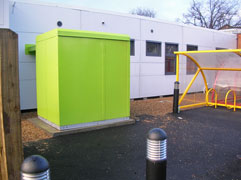Building Physics
Building physics is the science of designing, constructing, and operating high performance buildings that are durable, comfortable, energy efficient, affordable and healthy. Solving building problems requires an understanding of heat, mass transfer physics, material science, meteorology, thermogeology, construction technology, human physiology, and engineering analysis and design.
Temperature Control
The control of heat flow within buildings is important to ensure comfort, health, and productivity. It is necessary to control heat flow in order to save energy and reduce the carbon footprint of a building. Insulation and sealing are the basic tools for controlling heat flow, but thermal bridging must be understood to limit heat loss through conductive materials and elements in the building envelope. Assessing interior surface condensation and comfort are dominated by an understanding of surface temperature. Heat flows by many modes, and one of the most important is by air movement. Whether within an air handling unit or through a roof, heat transfer by air flow is important.
Orientation
One of the largest sources of energy to many buildings is the sun: solar gain through windows dominates the air conditioning loads of commercial buildings. Solar heat can be captured and used for water heating and space heating in carefully designed buildings.
Moisture Control
Moisture is the primary agent of deterioration in buildings, and hence controlling moisture is crucial to ensuring durability. Moisture is also the most common factor in indoor air quality problems such as mould and smells. The water molecule has many interesting properties that explain its odd behaviour and its interaction with materials. Air barriers, vapour barriers and capillary breaks are building products and systems whose major function includes moisture control. The required level of moisture control, depends on the quantity, phase (gas, liquid, solid), frequency of the load and the mechanism of movement that must be controlled. The primary sources of moisture: rain and snow, water vapour in the air, ground water, and construction moisture, have different magnitudes and have different significance in different climates, building uses, enclosure types, and materials. Moisture moves by a number of mechanisms: capillary flow, vapour diffusion, air convection, and gravity flow. Each of these mechanisms is driven by different forces and flows at different rates through different materials.
Air Flow Control
Air movement carries humidity, heat, pollutants, infections and sound. Controlling airflow, across the enclosure, between zones, and from the distribution system to hollow partitions is therefore required to achieve comfortable, healthy, and energy efficient buildings. Air movement is driven by pressure differences through flow paths: understanding the complex flow paths and dynamic pressure fields that act within a building is needed to design optimum paths.
Climate and Geology
Different climates, and different interior space conditions, require different layouts, materials, and design strategies. Increasing the complexity for building designers are different wind loads, earthquake risks, wildfire and flood probabilities. All these factors need to be taken into account in building design and construction to ensure the building is in tune with its environment. If ground source energy is to be used then a detailed knowledge of the local geology will be needed to design an effective ThermalBank to store heat from the summer when it is available to the winter when it is needed.
Acoustics
Noise control and aural communications in building spaces are both part of building physics. The basic physics of sound are well understood, but the interaction of sound pressure waves with complex shapes and a variety of surface materials is complex. Noise control is increasingly important in more high density housing, closer offices spaces, and busier streets and public places.
Light
Daylight is good for the spirit and provides energy. Uncontrolled solar penetration can result in over heating and causes the surface temperature of cladding to shoot up. Ultraviolet radiation can also cause deterioration in surface materials, inside and out.
See: Banking on IHT
See: Renewable Heating Renewable Cooling
See: Ground Source Energy How ground source heat pumps work
See: Ground Source Heating and Cooling
See: Energy Storage

